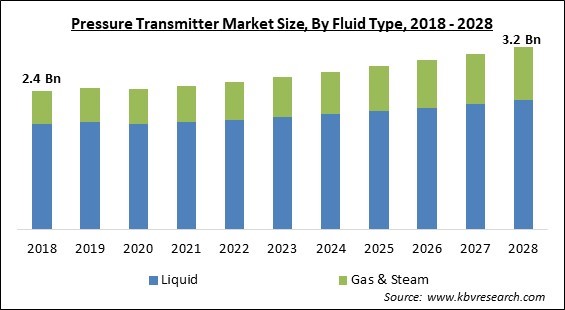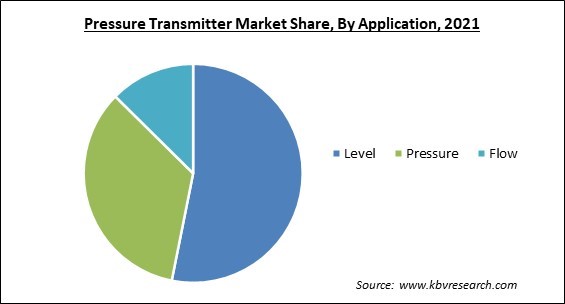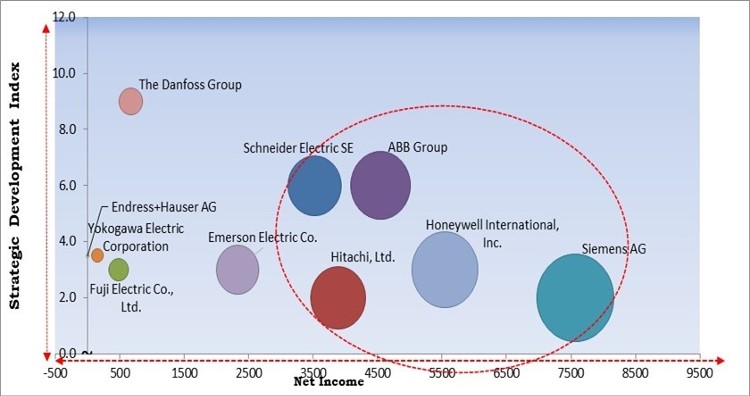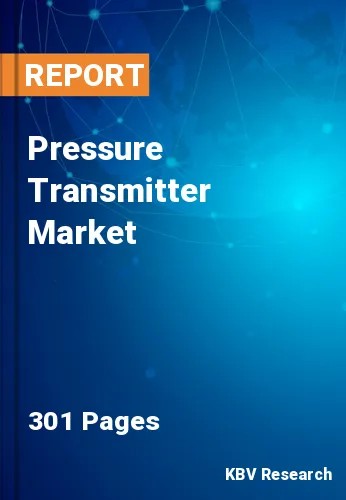The Global Pressure Transmitter Market size is expected to reach $3.2 billion by 2028, rising at a market growth of 3.6% CAGR during the forecast period.
A pressure transmitter is a device that controls the amount of compression that is applied to a liquid, fluid, or gas. The device detects quick pressure fluctuations and converts them into mechanical energy and electrical current. To correctly convey the current, it also includes an electrical amplifier and a pressure transducer. These transmitters are frequently used in conjunction with other instruments to detect leaks in industrial equipment by measuring depth, water flow, altitude, and pressure loss. Because they are resistant to radiation and electromagnetic forces, they have a wide range of applications in industries such as chemical, oil and gas, power production, food and beverages, metals and mining, and so on.

The movement of a diaphragm causes changes in electrical capacitance, which are measured by capacitive pressure sensors. Two parallel receiving plates are separated by a tiny opening in a capacitor. One of the plates serves as a diaphragm that is displaced by pressure, altering the circuit's capacitance. A circuit's resonant frequency can be measured as a result of the change. The time it takes to charge and discharge the capacitor can also be transformed into a series of pulses in a digital system.
Pressure transmitters, for example, actually measure levels of pressure as well as pressure differences. Pressure transmitters may operate in almost any condition and can even be submerged completely. They're made of piezoelectric materials, which are radiation- and electromagnetic-field-resistant. Pressure transmitters can be linked to other systems, such as electrical wiring, and calibrated to measure pressure in relation to atmospheric pressure.
COVID-19 has had a significant impact on the world economy and all industries around the world. During the first 1 to 2 months of 2020, the COVID-19 pandemic hampered the expansion of the pressure transmitter market. As many businesses have recovered after the pandemic, pressure transmitters have seen a boom in interest. Pressure transmitter market value chain has been significantly affected by the COVID-19 pandemic; however, the value chain has been consistently revived, resulting in continuous market expansion. In the post-pandemic period, a significant increase in the need for automation across processing industries such as chemical, water & wastewater treatment, oil & gas, and food & beverage, as well as a growing emphasis on real-time data analysis and predictive maintenance, is driving market expansion.
Industrial automation systems cut work, waste, and labor expenses, reduce downtime and inaccuracies, improve process quality, and shorten response and processing time by eliminating human intervention. A pressure transmitter is one of the most important field instruments in the industrial automation suite's measurement and analytics division, which ensures precise process measurements while also improving safety and productivity. Pressure transmitters collect and store vital data to improve industrial productivity, spot patterns, and make changes to avoid future events. This, in turn, improves manufacturing process efficiency, lowers maintenance costs, and boosts overall production. The cost of medical care, paid vacation, and holidays associated with maintaining a human operator are all eliminated with industrial automation.
The mass flow is measured and calculated by the multivariable transmitter as a function of temperature, total pressure, and pressure difference. Its key advantage is that it eliminates the need for many receivers and a mass transfer calculator in the field. The transmitters help to improve productivity, process efficiency, and plant safety while cutting the total cost of maintenance dramatically. Multivariable transmitters give the most accurate and realistic flow measurement by combining sensors built microprocessor innovation, and dynamic flow correction. Pressure gauges are available in a variety of accuracies. Typical pressure transducers have an accuracy range of 0.5 percent to 0.05 percent of full-scale output. When reading shallow pressures for important demands, higher accuracies are desired.
Industrial systems must be upgraded and maintained to meet changing company needs. Significant changes in software platforms that manage field instrumentation such as pressure transmitters and flowmeters have been observed as IIoT and Industry 4.0 technologies have become more widely adopted. Industrial automation has aided digital transformation while also increasing the complexity of the overall parameter measuring and analysis process. While productivity rises, the difficulty of staying current with regular upgrades rises as a result of the need to avoid unneeded downtime and failures.
By Fluid Type, the Pressure Transmitter Market is bifurcated into Liquid, Gas & Steam. The gas & steam segment recorded a significant revenue share in the pressure transmitter market in 2021. Transducers, such as gas pressure transmitters, emit an electrical signal proportional to the pressure they detect. Microprocessors, programmable controllers, computers, and other electronic equipment attached to the sensor can now monitor pressure. Pressure transmitters use the current output to send gas pressure values to a control or display device.
Based on the Application, the Pressure Transmitter Market is classified into Level, Pressure, and Flow. The flow segment witnessed a substantial revenue share in the pressure transmitter market in 2021. The outcome of a process in numerous industries, such as food and beverage, is fully dependent on various variables. The flow rate of the liquid, vapor, or gas is a significant factor among these variables. The flow of the fluid is measured using a variety of equipment. Flow transmitters are one of the most significant tools for the job. These devices, which are equipped with sensors, transmit an electrical signal to indicate the flow of liquid, gas, or a mixture of both.

Based on the Type, the Pressure Transmitter Market is segmented into Differential Pressure, Absolute, Gauge, and Multivariable. The multivariable segment registered a significant revenue share in the pressure transmitter market in 2021. The mass flow is measured and calculated by the multivariable transmitter as temperature dependent, total pressure, and differential pressure. It eliminates the need for many transmitters along with a mass transfer calculator in the field. The transmitters help to improve productivity, process efficiency, and plant safety while cutting ownership costs dramatically. Multivariable transmitters provide the most precise and reliable flow measurement by combining integrated sensors, microprocessor innovation, and dynamic flow correction.
On the basis of Industry, the Pressure Transmitter Market is fragmented into Oil & Gas, Chemical, Water & Wastewater Treatment, Food & Beverage, Power, Pulp & Paper, Metals & Mining, Pharmaceutical, and Others. The chemical segment recorded a substantial revenue share in the pressure transmitter market in 2021. Pressure transmitters can gauge the pressure of extremely corrosive process fluids using remote chemical sealing. The seal elements' housings and diaphragms are the only parts of the instrument that come into contact with the fluid medium. The capillary tubes joining the seals to the transmitter, as well as the transmitter itself, contain only clean oil.
| Report Attribute | Details |
|---|---|
| Market size value in 2021 | USD 2.5 Billion |
| Market size forecast in 2028 | USD 3.2 Billion |
| Base Year | 2021 |
| Historical Period | 2018 to 2020 |
| Forecast Period | 2022 to 2028 |
| Revenue Growth Rate | CAGR of 3.6% from 2022 to 2028 |
| Number of Pages | 301 |
| Number of Tables | 503 |
| Report coverage | Market Trends, Revenue Estimation and Forecast, Segmentation Analysis, Regional and Country Breakdown, Competitive Landscape, Companies Strategic Developments, Company Profiling |
| Segments covered | Fluid Type, Application, Type, Industry, Region |
| Country scope | US, Canada, Mexico, Germany, UK, France, Russia, Spain, Italy, China, Japan, India, South Korea, Singapore, Malaysia, Brazil, Argentina, UAE, Saudi Arabia, South Africa, Nigeria |
| Growth Drivers |
|
| Restraints |
|
Region wise, the Pressure Transmitter Market is analyzed across North America, Europe, Asia Pacific, and LAMEA. The Asia Pacific region procured a significant revenue share in the pressure transmitter market in 2021. Pressure transmitter sales are predicted to increase in the Asia Pacific region due to rising electricity demand, rising chemical exports, and the construction of industrial- and utility-grade wastewater treatment facilities. Additionally, a significant element propelling the expansion of the pressure transmitter market in the region is the region's expanding chemical and food and beverage industries.
Free Valuable Insights: Global Pressure Transmitter Market size to reach USD 3.2 Billion by 2028

The major strategies followed by the market participants are Product Launches. Based on the Analysis presented in the Cardinal matrix; Siemens AG, Schneider Electric SE, ABB Group, Hitachi, Ltd., and Honeywell International, Inc. are the forerunners in the Pressure Transmitter Market. Companies such as Emerson Electric Co. and Yokogawa Electric Corporation are some of the key innovators in Pressure Transmitter Market.
The market research report covers the analysis of key stake holders of the market. Key companies profiled in the report include ABB Group, Siemens AG, Schneider Electric SE, Hitachi, Ltd., Honeywell International, Inc., Yokogawa Electric Corporation, Emerson Electric Co., The Danfoss Group, Fuji Electric Co., Ltd., Endress+Hauser AG.
By Fluid Type
By Application
By Type
By Industry
By Geography
The global pressure transmitter market size is expected to reach $3.2 billion by 2028.
For Optimal Resource Utilization, There Is a Growing Emphasis on Industrial Automation are driving the market in coming years, however, Regular Software Updates and Maintenance Requirements limited the growth of the market.
ABB Group, Siemens AG, Schneider Electric SE, Hitachi, Ltd., Honeywell International, Inc., Yokogawa Electric Corporation, Emerson Electric Co., The Danfoss Group, Fuji Electric Co., Ltd., Endress+Hauser AG.
The Liquid market acquired maximum revenue share in the Global Pressure Transmitter Market by Fluid Type in 2021, and would continue to be a dominant market till 2028; thereby, achieving a market value of $2.3 billion by 2028.
The Level market has shown high growth rate of 3.3% during the forecast period.
The North America market dominated the Global Pressure Transmitter Market by Region in 2021, and would continue to be a dominant market till 2028; thereby, achieving a market value of $1.1 billion by 2028.
Our team of dedicated experts can provide you with attractive expansion opportunities for your business.

